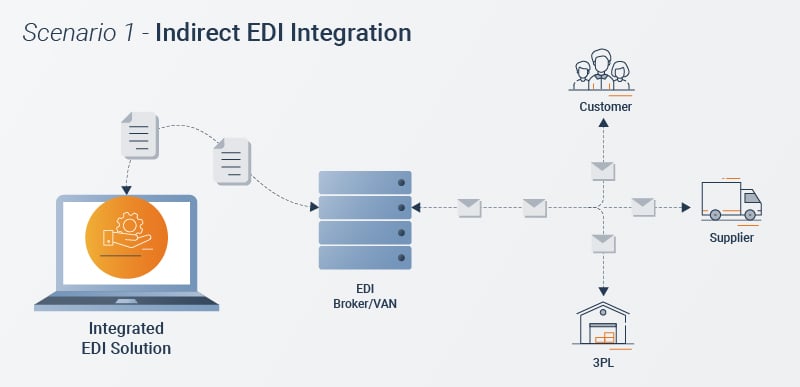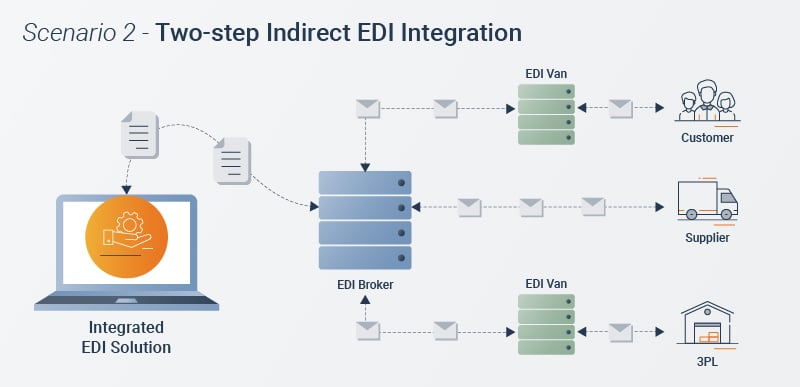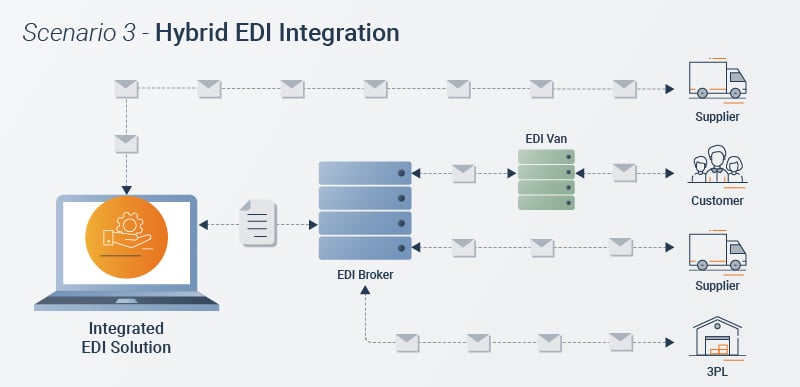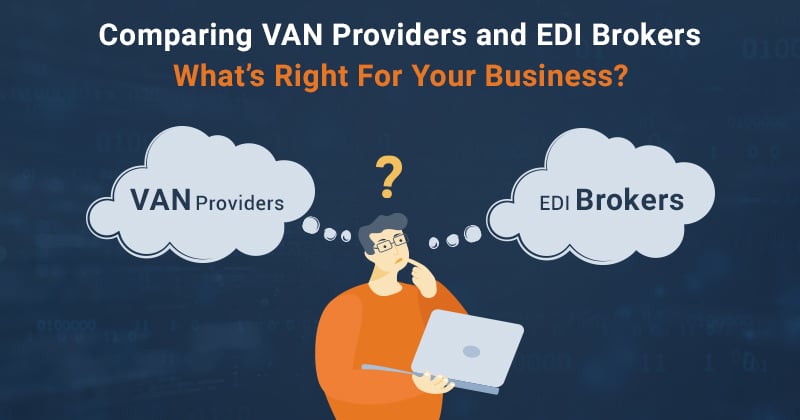Once you start researching Electronic data interchange or EDI providers, you have so many different terms thrown at you, it can surely get overwhelming. You probably have read about various EDI service providers and the services each of them offers. If you are confused about including an EDI VAN provider and/or EDI broker in your EDI strategy but unsure about which scenario will work for your business, then you’re in the right place.
At To-Increase, we specialize in developing solutions that add value to Microsoft Dynamics 365 for Finance and Operations or Finance and Supply Chain Management, AX, and NAV ERP systems. We provide various software solutions across industries with more than 2,200 customers worldwide.
We, as EDI solution providers, work with both EDI VAN providers and brokers for a lot of our customers. We know that working with each option has its own benefits and limitations. However, it is important to first assess your EDI requirement before you can make a choice. This article will help you understand the differences and make an informed decision.
VAN Providers
What is an EDI VAN provider?
VAN is an abbreviation for value-added network. EDI VAN providers have been around since the birth of EDI technology and the establishment of standard formats for EDI. Initially, a communication method that used a phone line and a modem were used. But this meant that the company would have to maintain a connection for every trading partner. Every connection needed to be configured, tested, and upgraded with time. The VAN provider did all of this on behalf of the company with one connection for the company to maintain and liaise with.
So, you can therefore say that VANs provide a service similar to a post office. They provide a third-party network that organizations can connect their EDI Solution to, to send and receive messages in different standards and formats with trading partners. They act as messengers delivering the message in the format received from one end to the other end of the network. They do not provide any services to translate the message into a different standard. They just deliver the message as it is from company A to company B and back.
What kind of services do they provide?
VANs provide a secure, outsourced network that connects organizations with their trading partners across the globe. A hosted VAN Provider can easily transmit and pass on communications between a private network or a cloud-based EDI provider as they are pre-connected to the trading partner community.
VANs provide a mailbox service and transmit your documents to the mapped trading partner’s mailbox. The message is formatted and validated before it is transferred to the trading partner. Your trading partner will receive an intimation and then connect to the VAN to receive the document.
Some EDI VANs offer data-related services such as data backup and recovery. Some of them also offer additional services such as document mapping, compliance, basic auditing, and reporting services to track your EDI system’s performance.
How do you transfer your EDI-related data with VANs?
Usually, you share your documents with the VAN provider through the internet. Alternatively, you could set up a more secure connection such as an Applicability Statement 2 (AS2) protocol.
Can VANs provide integration for your ERP systems?
Most VANs do not provide this service and you would have to consult with your EDI solution provider in this case.
What are the benefits of working with VANs?
1. Quick set-up: Most VANs set up connections for every trading partner for you, then test and maintain that connection. You don't need to spend any time or effort on understanding and tracking the different EDI standards and formats your trading partners use. However, VANs will not translate the message into a different standard.
2. Low start-up fees: VANs usually charge minimal fees for setting up and then have a per-transaction charge. Some of them also charge per line item. If you have a partial direct connection and use VANs sparingly for just a handful of EDI partners, then your costs will remain low even later on.
3. Support for several EDI standards and protocols: EDI VANs usually support almost every message standard and there are several. They also support a lot of protocols that are used to transfer the messages to your trading partners.
4. Reliable data transfer: VANs can use more secure modes of EDI that use encryption and guarantee a safer way to transfer your messages.
5. Access to a large existing network: When you partner with a VAN, you automatically get access to their existing global/regional network, so onboarding trading partners and exchanging documents via their network is quicker and easier than doing this yourself.
6. Validation of data exchange: Most EDI VANs will validate and format the message and confirm the trading partner’s details prior to sending out the message. This adds a layer of quality checks to the EDI process. Additionally, the messages are stored and can be easily pulled out when it is time to work on reporting.
What are the limitations of working with VANs?
1. Price model: As VANs charge per transaction or line item, if your document exchange volume increases, so will your EDI costs for transactions going through your VAN provider. Many VANs have add-on costs if you exceed a certain transaction volume. Find out about all these extra and underlying costs before signing up with a VAN.
2. Data transfer is your responsibility: Generally, VANs use web EDI wherein you can send and receive documents. However, you need to key in the information manually or you could set up an automated process for this. And if you need to transfer this information to your ERP system, unless integrated with your EDI solution, you will need to transfer this information again.
3. Trading partner set-up can take time: The time taken to onboard a new trading partner would depend on the capability and bandwidth of the VAN vendor. And for any issues that come up during document exchange with your trading partners, you need to initiate a ticket and wait for a resolution from the VAN provider, with minimal visibility on the steps involved in tackling the issue.
4. Lack of EDI Translation and non-EDI messaging: EDI VAN providers do not translate the message into different message standards, so you need to either do it in-house or reach out to an external vendor for this service. Additionally, if you have non-EDI partners and need to transmit the message as a PDF you need to reach out to a broker that provides this service.
EDI Brokers
What is an EDI Broker?
An EDI broker also provides a VAN network or might connect to a few VANs in places where they do not have their own network. However, in comparison to VANs, they add more value to the service. For example, a broker can receive a letter in your followed document format and translate it based on the format and standard followed by your trading partners. Most brokers offer 2500 different formats on average, which is very beneficial if you have a global operation.
Some EDI brokers are also fully managed services providers, which means that they offer an end-to-end EDI service, which includes the EDI Solution, customer mapping, message translation and validation, and message delivery.
What kind of services does an EDI broker provide?
Most EDI brokers provide translation, validation, and a safe way to share EDI documents with business partners with support for all EDI standards and formats. The EDI broker onboards EDI partners and some fully managed service providers integrate the EDI data with your EDI solution and ERP.
How do you transfer your EDI-related data with EDI Brokers?
The data transfer is similar to how you would transfer data to EDI VANs. Most of our customers prefer transferring data via AS2 and HTTPS protocols.
Can EDI Brokers provide integration for your ERP systems?
Some brokers will provide integration through an external system, while some will have their own teams take care of the integration process. In rare cases, fully managed service providers offer an integration platform for connecting the EDI solution to your ERP. In the case of our solution, our team of experts help our customers with ERP integration. Additionally, our team can also train you to manage the integration of all your business systems using Connectivity Studio for Microsoft Dynamics 365 Finance & Supply Chain (D365 F&SCM).
What are the benefits of working with EDI brokers?
1. Convenient and saves time: Working with an EDI broker makes life easy for the customer as they don’t need an external party to translate the messages for them and this also saves time as the message is translated and dispatched by the EDI broker.
2. Quick onboarding of trading partners: EDI brokers provide mapping of customers; they can provide an out-of-box service or customize mapping so onboarding of trading partners becomes quicker and more efficient.
3. End-to-end messaging: Very few EDI brokers provide non-EDI messages. A non-EDI message is a message transmitted as a PDF and emailed - PDF2XML. This service can make the communication process seamless for every kind of document exchange — EDI or non-EDI.
4. Low maintenance: With EDI brokers because of the extent of services, the support offered, and processes in place, the effort you need to spend on maintenance is lesser.
5. One point of contact: Working with EDI brokers that provide an end-to-end EDI solution means one contract for the customer and dedicated resources responsible for all your EDI operations.
What are the limitations of working with EDI brokers?
1. Cost: Just like VANs, EDI brokers' services are priced as pay-as-you-go. However, in comparison to VANs, the costs are higher as they also provide more services. If you are paying per transaction and exchange a large number of messages via the EDI broker, then the price of your EDI messaging increases unless you look at a hybrid scenario.
2. Onboarding could take time: This depends on the EDI Broker’s bandwidth but if you decide to go with a scenario where you connect to an EDI broker and a VAN, expect a wait-time to get everything set-up and started before you can start using the EDI solution to message customers via the EDI broker.
When should you use an EDI VAN and/or EDI Broker?
Let’s look at some recommended scenarios where tying up with an EDI broker or/and a VAN would be beneficial.
Scenario 1 – Indirect integration
In an indirect EDI integration, you have an existing partnership with a VAN or broker for EDI messaging.

Company A needs certain messages translated and reaches out to a broker, or Company A needs to reach out to certain trading partners in a different network and connects with a VAN provider.
After company A transmits the message to the EDI broker in the first instance, the broker translates the message and sends it to the trading partner. In the second instance, the VAN receives the message and transmits it as it is to the customer/supplier or 3PL partner.
Scenario 2 – Two-step indirect integration
Two-step indirect integration is where your EDI broker partners with a VAN provider for certain trading partners.

Company A has multiple trading partners spread across the globe, and the EDI broker does not have connections with all of them. In that case, Company A would connect with an EDI broker, which would connect with a VAN. The EDI broker will receive the message, translate it and share it with the VAN provider and the message will then be transmitted to the customer or 3PL partner. Or in the case of the supplier, the message is translated and then sent to the supplier.
Scenario 3 – Hybrid EDI integration
In scenario 3, which is a hybrid set-up, you have a mix of direct EDI messaging along with connecting with a broker for reaching out to your customers, suppliers, and 3PL (third party logistics) partners.

Some of your customers out of your broker’s network need that message translated to a different standard, so your broker could translate that message and share them with the VAN provider who could then transmit the message to your customers.
Our recommendation
In every scenario mentioned in this blog, wherein you need to connect your integrated EDI solution to your trading partners, you can consider using a stand-alone EDI solution. However, as your scale of business and document exchange increases, and you need to connect to several trading partners across the globe, we recommend connecting with VANs and EDI brokers.
While some brokers might partner with VANs and provide one point of contact for all your messaging, some of your trading partners might insist on connecting to their EDI broker or VAN of choice, in that case, your choices of course are then limited.
Our personal recommendation is to connect with an EDI broker that offers flexibility, visibility, and low wait time for implementation. An EDI broker that can provide valuable services such as message translation and non-EDI will be more favorable for all your EDI messaging needs in the long run.
For more information on all things EDI, we suggest downloading our EDI toolkit that covers implementation challenges, EDI scenarios, and factors to consider while evaluating EDI providers and several other topics.





